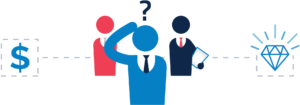Long-Term Agreements: What’s the Best Pricing Strategy?
Long-Term Agreements: What’s the Best Pricing Strategy?
 How often do you experience one of these situations?
How often do you experience one of these situations?
• You have a customer who is promising to purchase a large volume in the upcoming year. Over the next 12 months, they intend to buy a significant amount of product over several orders. Of course, they want your very best price. You sharpen your pencil and calculate a heavily discounted price based on the volume promised. However, at the end of the year, you realize that the customer has ordered significantly less than originally promised. You never planned to sell at such a low price for so little volume. Unfortunately, the year is over, and you have little recourse for rectifying the situation without jeopardizing your ongoing relationship with this client.
• You have a long term agreement with a customer for 100,000 units at a discounted price. You are at the end of the contract period and the customer has purchased only 40,000 units. Now it’s time to renegotiate the contract, and the customer is expecting the same low price.
What do you do?
In each of these cases, the structure of your arrangement makes taking corrective action difficult if not impossible. In short, there isn’t much you can do to remedy what has already happened. However, you can prevent this from happening again. Here is a recommendation from the pricing consultants at PricePoint Partners.
The solution is to create a pricing schedule that offers incremental discounting as volume levels are actually achieved rather than simply as they are promised. For example, if the customer plans to purchase 10,000 units over a 12-month period, set a higher price for the first 2,500 units; a slightly lower price for the next 2,500; a lower price yet for the next 2,500; and your lowest price on the final 2,500.
Structure your price points so that you will ultimately generate the same revenue as you would have if you had quoted a single price at the onset. This means that, by the time you get to the last order of 2,500 units, the per-unit price will be even lower than if you had initially quoted the quantity discount on 10,000 units.
Earn-As-You-Go Strategy
This earn-as-you-go pricing strategy ensures that your customer earns the full volume discount upon fulfillment of the terms of the agreement while it safeguards you from revenue and margin loss. You will consistently attain your target price and profit levels while recognizing the customer’s climb in volume.
In addition to protecting your pricing and margin levels, this pricing strategy provides a more balanced negotiating strategy as buyers wave intoxicating volumes in front of your sales team. In the end, it is fair and balanced for both buyer and seller.
